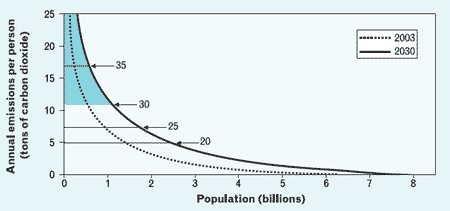 |
In a Newswatch interview, Heleen de Coninck discusses the allocation of national targets based on individual emissions. |
| Heleen de Coninck, a specialist in international climate policy and technology, manages International Energy and Climate Issues in the unit Policy Studies at the Energy Research Centre of the Netherlands. | |
Tiempo Climate Newswatch: You’ve been working with institutions in Italy and the United States on a fairer way of allocating emissions targets between nations. What’s the problem with the current system, agreed in Kyoto some years ago?
Heleen de Coninck: In the Kyoto Protocol, emission allocation depends on a number of things, but particularly the average income of the countries. Countries with a high average income get targets; countries with low average incomes do not. The premise is that emissions depend on income. To some degree, this is true. But the approach is not perfect. By taking average emissions, it ignores the fact that, in low-income countries, there are millions of individuals who have very high emissions. These people are not faced with any climate policy, and essentially free-ride on the vast numbers of poor people in their countries. In India, for instance, there are 600 million people who emit practically nothing at all, but also some 50 million (about the amount of people living in France) who have emissions on a par with the European average.
Tiempo Climate Newswatch: What are the main elements of your proposal that climate policy should be based on individual emissions?
Heleen de Coninck: It is essentially a calculation method for the national allocation of carbon dioxide emission allowances. We start from the premise that every individual should be treated the same, regardless of which country they live in. We calculate the individual emissions by taking the income distributions of countries, and multiply them with the country-specific carbon intensity. Gathering all individuals in all countries together for, say, 2003, you can combine over six billion individuals, each with their individual emissions, in one curve, as in the diagram.
 |
| Cumulative population ranked by carbon dioxide emissions. Thresholds defined by the global emissions caps of 20, 25, 30 and 35 gigatons are indicated by the horizontal arrows. |
By making projections of income distribution and carbon intensity for the year 2030, and again adding up all the countries’ individuals, you get the same curve, but, reflecting population growth, now with 8.1 billion data points, each representing a person with a certain carbon dioxide emission level based on their income and the carbon intensity of the country they live in. This curve would show a greater surface area than the curve for 2003, as emissions are projected to have risen by 2030.
If one would then set a global emission target for 2030, for example, 30 gigatons of carbon dioxide (GtCO2) in total, and allocate that to the low emitters first and the high emitters last, you arrive at a global personal cap. A country’s national cap depends on the number of individuals above the personal cap. So, if a country only has inhabitants who are below the cap, it gets no target and it can develop according to business as usual. If it has a small population that exceeds the cap, it gets a country-wide target that allows those below the cap to develop normally, but which caps those in the country with higher emissions than the personal cap. The result is a per-country allocation based on the number of individuals with high emissions.
Tiempo Climate Newswatch: Taking account of the distribution of income within a country distinguishes this scheme from more conventional approaches. but doesn’t the allocation of targets based on projections of income distribution and carbon intensity create a major source of uncertainty? At the least, wouldn’t the targets need to be continually revised?
Heleen de Coninck: This is a question of how to implement the scheme in practice, if countries agree on the principle. Indeed, the targets may need updating, perhaps every five years or so. This would slightly change the target setting from year to year for countries, but the difference is not expected to be large. In general, there are many practical issues that need to be resolved. The data framework now is only about carbon dioxide, for example. Other greenhouse gases would ideally be incorporated, but the relation with income is less clear, so income distributions might not be the best approximation of individual emissions.
Tiempo Climate Newswatch: The major developing nations are resisting pressure to accept some control on emission growth. would this scheme make it more likely countries such as China and india would take on a formal commitment?
Heleen de Coninck: In our view it might. The main reason India and (to a lesser degree) China state for their resistance of emission caps is that their first priority is to lift those hundreds of millions of poor people out of poverty, not to reduce emissions. But in this approach, their targets would be based only on those people that are not living in poverty - it is the more affluent people who appear higher on the income distributions and, hence, have higher emissions and these are the ones the country cap is based on. In addition, it provides the rich countries, which have many more high emitters, with more stringent targets than poorer countries.
Apart from that, it provides a framework that honours equity, the reason we feel this approach might help is because of the results it gives. For a 30 GtCO2 global cap in the year 2030, around 1.2 billion people around the world are considered high emitters, and the countries where they live are thus faced with targets. Of these 1.2 billion, around 300 million live in the United States (it corresponds to about 85 per cent of the population), around 300 million live in China, around 300 million in the rest of the Organisation for Economic Co-operation and Development and 300 million live in the rest of the world, mainly in oil-and gas producing countries with high carbon intensities. Although the United States and China targets are comparable in terms of the number of people, the United States target is more stringent as its high emitters emit much more than the high emitters in China. In that sense, this approach generates common but differentiated results - which follows the United Nations Framework Convention on Climate Change to the letter.
 |
|
Drax coal-fired power station, United Kingdom
© Richard Clay/SEI |
Tiempo Climate Newswatch: How does this proposal link to poverty alleviation, a more immediate issue than climate change for many of the world’s population?
Heleen de Coninck: In one version of our approach, we allow a poverty headroom for 2.7 billion people in 2030 who emit less than one ton of carbon dioxide (tCO2) per person per year. If they are allowed to grow to one tCO2 per person a year, which would mean considerable alleviation of poverty, the global personal cap for the high emitters only decreases by 10 per cent or so. We argue very much that something like this is done so our approach is even more consistent with development goals.
In principle, the approach only caps those who have high emissions, and lets the low emitters, the poor of the world, develop according to business as usual. However, it is only an allocation scheme and does not prescribe national policies. The rich and high emitters are often in power in poor countries. It could well be that emission reductions required are eventually taken out on the poor - the approach does not control that part as this is a case of national sovereignty. This might also happen if China or India would accept a target based on per-capita average emissions.
The approach, therefore, does not give guarantees for poverty alleviation; it is designed to be an emission allocation calculation method. However, it is consistent with poverty reduction objectives as it in principle does not deny any individual or country the right to develop.
Acknowledgement
Development of the scheme is a collaborative project between Princeton University and Harvard University in the United States, Fondazione Eni Enrico Mattei in Milan, Italy, and the Energy Research Centre of the Netherlands.
Further information
Heleen de Coninck, Energy Research Centre of the Netherlands, Radarweg 60, PO Box 56890, 1043 NT, Amsterdam, The Netherlands. Fax: +31-224-568339 Email: deconinck@ecn.nl. Web: www.ecn.nl.
On the Web
Further details of the proposed scheme are available in a Powerpoint presentation.